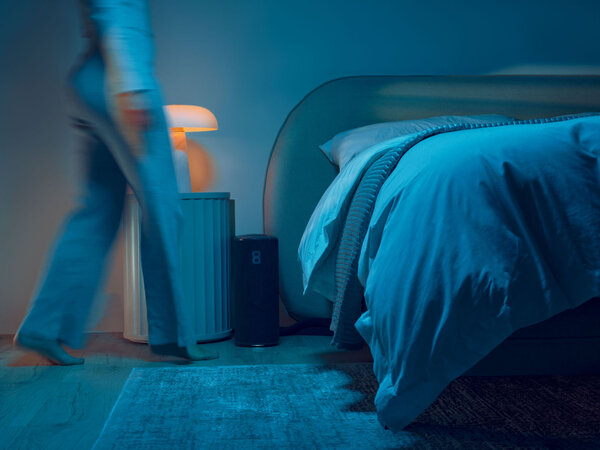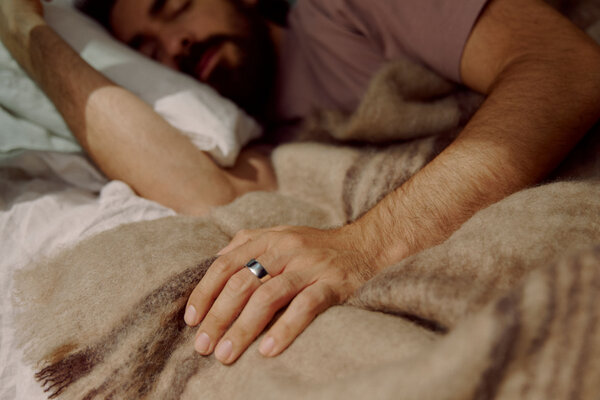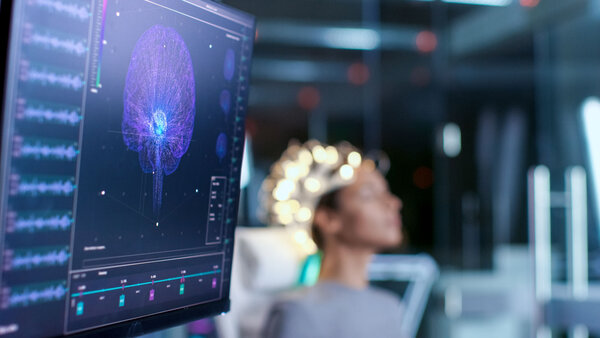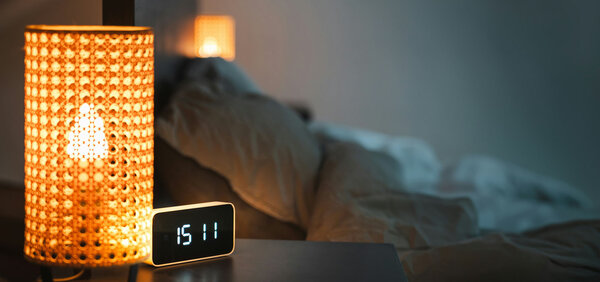I woke up at 5:30am in a tangle of wires – two straps around my waist, a pulse oximeter on my left index finger, two tubes shoved up my nose. At 6:00am, the hour I was permitted to remove the device, I tore it from my body and threw it across the bed. With no caffeinated beverages available as consolation, I made myself a cup of herbal tea.
It’s ironic that the first night of my sleep retreat should be so bad. Or maybe not, considering I am a terrible sleeper. Constantly ping-ponging across the globe, I am perpetually jet-lagged and out of routine. Even when I’m grounded at home, snoozing does not come easily. No matter if I go to yoga, marinate in a magnesium bath, lather myself with lavender oil and avoid my screen before I climb under the covers, chances are that I’ll be tossing and turning all night.

Photo Courtesy Eight Sleep
I am not alone. One in three people struggles with sleep. While research shows that our snooze quality has deteriorated in recent years, bad sleep also isn’t entirely new. For decades, it has been common for people to pull all-nighters without considering the biological consequences. Hell, it’s often even praised.
“Over the past 40 years, [we’ve started] understanding the importance of sleep,” says Russell Foster, an Oxford sleep scientist and author of Life Time. “It has gone from being recognised as an indulgence to a realisation that our ability to function during the daytime is defined by the quality of the sleep we get the night before.”
Hence the sleep market is booming. Products such as Oura Rings, which track sleep cycles, and cooling mattresses that reduce body temperature, are everywhere. Hotels are launching sleep protocols, too. Equinox held a major sleep symposium and Hilton is launching new sleep programmes led by a sleep scientist. Suddenly, the world has woken up to the fact that good slumber is a lot more important than we’d previously thought.

Photo Courtesy Oura Ring
Which is why I’d found myself on a sleep retreat at Palazzo Fiuggi, lying in a tangle of wires which belonged to a cardiorespiratory polygraphic device that tests for sleep apnea. It’s a major disorder that affects one in eight people: when breathing stops and starts throughout the night triggering the brain to stay awake and ultimately not allowing the body to enter into a deep sleep.
The polygraph is one of the many tests that form the sleep programme at Palazzo Fiuggi, a medical spa in a historic building in the hills outside Rome. The new protocol was born out of the realisation that patients were arriving at the property battling with shut-eye.
“We discovered that one of the biggest issues is sleep disorders,” says David Della Morte Canosci, the medical spa’s lead doctor and professor of neurology. “Many people who come here are experiencing high stress or job-related issues and they lose their circadian rhythm,” he adds. “We are trying to regulate that.” The circadian rhythm, aka the body clock, tells the body when to sleep and wake during a 24-hour cycle. When it’s out of sync, it negatively impacts our sleep, creating a domino effect.
Most of us are familiar with the repercussions of not getting a good night’s rest: we are irritable, anxious, stressed and less productive – sound familiar? But research also suggests that the impact of long-term sleep deprivation can be far more serious than a bad mood. “If you have a sleep disorder, you are more prone to develop diabetes, cardiovascular disease, even dementia,” says Della Morte Canosci. Poor sleep is also linked to a number of conditions such as digestive issues and weight gain.
To rule out any serious sleep disorders, I was subjected to several tests on arrival at Palazzo Fiuggi. In addition to the sleep apnea test, I underwent an electroencephalogram (EEG), for which my head was covered with what looked like a swimming cap with a web of electrodes to test the electrical activity in my brain. I had an hour-long session with a sleep psychologist during which we took a deep dive into my habits and how I function throughout the day.

Photo via Getty Images
I was given numerous devices to wear: an actigraph, which looks like a boring version of a Casio watch and has a sensor that monitors my movements and studies circadian rhythms. Before bed, I strapped on a wearable infrared device that sends wavelengths of near-infrared light to activate the brain’s natural energy production and regenerative process. Wearing it across your forehead (cerebral area) is meant to boost cerebral metabolism and mitochondrial biogenesis (the production of new mitochondria).
“There is interesting research and data on the efficacy of this technology in the evenings – in sleep disorders and insomnia and the treatment of depression,” says Marco Infante, medical spa vice director and professor of endocrinology.
All of this is done in tandem with alternative treatments. I spend the days doing various treatments from vitamin-C IVs to cryotherapy, reflexology, yoga and even soaking in mineral-rich baths. When I have an hour to spare, I make use of the sauna and cold plunge pool, which is good for inflammation and aids sleep. “We decided on a holistic approach, which is based on medicine and technology, as well as meditation and relaxation,” says Della Morte Canosci.
According to the professionals at Palazzo Fiuggi, bad sleep usually has another root cause. “I’d say that most people don’t have sleep problems, they have stress or anxiety problems,” agrees Foster. It isn’t outrageous that studies have found that sleep disorders have risen since we collectively experienced the global pandemic. In 2022, 74 per cent of UK adults reported a decline in quality sleep over the previous 12 months.

Photo via Unsplash
In addition to anxiety and stress, there are also the more mundane influences that have become part of modern daily life, such as technology and social media. Rebecca Robbins, sleep scientist, co-author of Sleep for Success!, composed a study that tests screen time before bed. It found that when they exposed one set of individuals to a screen-free environment and another to screens, the latter group took twice as long to fall asleep. “The fundamental architecture of their sleep actually changes,” says Robbins. “So they spend less time in rapid eye movement sleep – the good sleep that allows us to wake up and be restored and refreshed.”
The process that leads up to bedtime should not be underestimated. “There is an opportunity to promote awareness about the time before sleep being just as important as sleep itself,” Robbins points out. And, in truth, it begins the minute we wake up, which often starts with coffee. Caffeine is one of those hot topics on which most experts have differing opinions, likely because it’s a product that impacts everyone differently. “There is individual variation to caffeine,” says Foster. “Some people can catch a whiff of coffee and feel alert, while others can enjoy countless cups and aren’t impacted at all. My rule of thumb is that, ideally, don’t have strongly caffeinated drinks after 2pm.”
The real problem is when overtired people use it as a crutch. “So many people who are chronically tired will drive the waking day with endless cups of coffee,” says Foster, adding that the survival time of coffee in the body lasts hours. “Drinking coffee in the afternoon will almost certainly delay sleep onset.” The other drink that disrupts shut-eye is alcohol. The neurologist at Palazzo Fiuggi warned me that, while drinking alcohol can help you fall asleep during the first part of the night, it disrupts the continuity of sleep during the second part.
There’s also exposure to natural light. Robbins stresses how important it is to experience blue light (from the sun). Whether that’s through sitting in the sun or taking a walk, it’s generally recommended that, at the minimum, we should try to absorb 10-15 minutes of sunlight (20-25 minutes on an overcast day) every day, preferably in the morning. Routine proves to be critical in all this. Sleeping and waking at the same time, getting enough hours in per night (many experts recommend around seven to eight, though Foster argues that this changes based on age). Some experts recommend sleeping in a room that is 18 degrees Celsius, as sleep can be fragmented when our bodies overheat.
There’s a lot we can do to mitigate a bad night: pre-bedtime meditation, journalling, the use of essential oils. We can add a cooling mattress, get blackout shades and use an Oura Ring. But Foster warns that we also run the risk of becoming obsessed. “We’ve gone from ignoring sleep to embracing sleep to being terrified of sleep,” continues Foster, who references Roger Ekirch’s book At Day’s Close: “In the pre-industrial era, it was common for people to sleep with dusk, wake with dawn, and also wake up multiple times during the night.”

Photo via Unsplash
Waking up multiple times during the night is something I can relate to – it’s seldom that I will sleep through the entire night, often bursting awake at 3am. “When it comes to sleep, the idea that everybody wears the same shoe size is nonsense,” says Foster. “Sleep changes as we age and we should not be frightened of these changes.” Even during my five-night retreat, I didn’t snooze perfectly every night. But I did wake up most mornings feeling rested and calm, which I’m told is a positive sign of a good night’s rest. I was also able to rule out sleep apnea or abnormal electrical activity in my brain, which gave me peace of mind. It turns out that I, like most people, am just stressed and anxious. My history of digestive issues also does not help.
The neurologists at Palazzo Fiuggi recommended I do the following: get a big old journal and write down my anxieties before bed and maybe download the Timeshifter app to help me adjust to new time zones. They stressed the obvious, too: cut down on caffeine and alcohol and don’t look at my screens when I’m in bed. I was expecting some kind of revelation, but this was hardly rocket science. Which, in a way, also made me feel as though my “sleep disorder” is a lot more manageable than I’d previously thought and, for better or worse, many of the solutions lie in my hands.
“Sleep is fundamentally a consequence of our daytime behaviours,” says Robbins, adding that things like stress management, sitting at a computer all day and food habits can impact the night ahead. It’s also OK to accept that “sleep is not going to be perfect every night”. A useful reminder not to spend every waking hour worrying about the dark hours ahead.
Curate your home and habits with these slumber-promoting solutions.
Foam mattresses can trap heat, so if you run hot during the night, opt for a mattress with springs. Or add a cooling layer such as Savoir Beds’ Climate Control mattress protector.
For even more cooling, try the Eight Sleep Pod 4 Ultra, which has a built-in cooling system.

Photo Courtesy Savoir Beds
Depending on what you eat for dinner, certain foods can spike your glucose and disrupt sleep. A continuous glucose monitor, such as this one from Levels, tells you which foods raise your glucose so you can avoid midnight peaks and slumps.
Research has shown that Niraxx’s wearable sends wavelengths of near-infrared light to activate the brain's natural energy production and regenerative process, which improves the length and quality of sleep.
In cases of persistent restlessness and exhaustion, these comprehensive programmes at top medical spas are designed to pinpoint and alleviate issues that extend beyond simple sleep hygiene.
The Sleep Diagnostics programme at Grand Resort Bad Ragaz relies on video polysomnography to record all disruptive factors during your sleep, facilitating an accurate diagnosis of sleep-related disorders and accompanying treatment recommendations.

Photo Courtesy SHA Spain
At SHA Spain, the integrative Sleep Well programme combines specialised sleep testing with treatments that address mental, physical and nutritional needs, with the aim of gradually establishing healthy sleep patterns for long-term results.
Chenot Palace Weggis offers a dedicated Sleep Cycles programme, which – after identifying your unique chronotype – sets out to train the body and mind to respect your natural circadian rhythm, while also improving sleep architecture in order to optimise the body’s restorative processes during slumber.